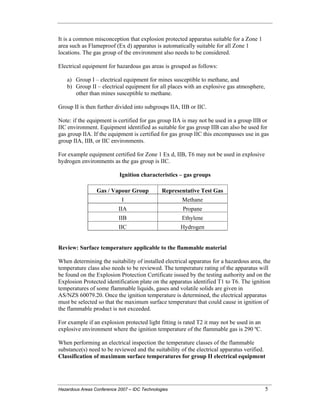Facts About Roar Solutions Uncovered
Facts About Roar Solutions Uncovered
Blog Article
The Buzz on Roar Solutions
Table of ContentsTop Guidelines Of Roar SolutionsThe Only Guide for Roar SolutionsRoar Solutions Can Be Fun For Everyone
In order to shield setups from a possible surge a technique of evaluating and classifying a possibly harmful location is needed. The objective of this is to make certain the proper option and installment of devices to eventually protect against a surge and to make certain security of life.
(https://dzone.com/users/5292804/roarsolutions.html)
No equipment needs to be mounted where the surface area temperature level of the tools is more than the ignition temperature of the provided danger. Below are some typical dust unsafe and their minimal ignition temperature. Coal Dust 380C 225C Polythene 420C (thaws) Methyl Cellulose 420C 320C Starch 460C 435C Flour 490C 340C Sugar 490C 460C Grain Dust 510C 300C Phenolic Resin 530C > 450C Aluminium 590C > 450C PVC 700C > 450C Residue 810C 570C The chance of the danger existing in a concentration high sufficient to trigger an ignition will certainly differ from area to place.
In order to classify this danger an installation is separated into areas of threat relying on the quantity of time the hazardous exists. These areas are referred to as Zones. For gases and vapours and dirts and fibres there are three zones. Zone 0 Zone 20 An unsafe ambience is highly likely to be existing and might exist for lengthy periods of time (> 1000 hours annually) or perhaps continually Zone 1 Zone 21 A dangerous atmosphere is feasible yet not likely to be existing for long durations of time (> 10 450 C [842 F] A category of T6 implies the minimal ignition temperature is > 85 C [185 F] Hazardous location electrical tools perhaps developed for use in greater ambient temperatures. This would indicated on the ranking plate e.g. EExe II C T3 Ta + 60C( This implies at 60C ambient T3 will not be exceeded) T1 T1, T2, T3, T4, T5, T6 T2 T2, T3, T4, T5, T6 T3 T3, T4, T5, T6 T4 T4, T5, T6 T5 T5, T6 T6 T6 A T Course rating of T1 implies the maximum surface area temperature produced by the instrument at 40 C is 450 C. Thinking the connected T Course and Temperature ranking for the equipment are ideal for the area, you can always utilize a tool with a much more rigorous Division score than needed for the location. There isn't a clear solution to this concern sadly. It really does depend upon the sort of tools and what fixings need to be accomplished. Tools with specific examination treatments that can't be done in the field in order to achieve/maintain 3rd party rating. Have to come back to the factory if it is before the tools's service. Field Repair By Authorised Worker: Difficult testing may not be called for however specific treatments might need to be adhered to in order for the tools to preserve its 3rd party score. Authorized workers have to be employed to do the work properly Fixing must be a like for like replacement. New element have to be considered as a straight substitute calling for no unique testing of the devices after the fixing is full. Each piece of devices with a hazardous score need to be reviewed independently. These are outlined at a high level listed below, but also for even more detailed information, please refer directly to the guidelines.
The Ultimate Guide To Roar Solutions
The equipment register is an extensive database of tools records that includes a minimum set of areas to identify each product's location, technological parameters, Ex-spouse category, age, and environmental information. The proportion of In-depth to Close examinations will certainly be determined by the Equipment Danger, which is analyzed based on ignition threat (the likelihood of a resource of ignition versus the possibility of a flammable atmosphere )and the harmful area classification
( Zone 0Area 1, or 2). Carrying out a robust Risk-Based Inspection( RBI )method is important for ensuring compliance and security in taking care of Electric Devices in Hazardous Areas( EEHA).
Some Known Details About Roar Solutions

In regards to explosive my latest blog post threat, a dangerous area is a setting in which an eruptive environment exists (or might be expected to be present) in amounts that call for unique precautions for the building and construction, setup and use equipment. electrical refresher course. In this post we check out the obstacles dealt with in the office, the danger control measures, and the called for competencies to function securely
It is a repercussion of modern-day life that we manufacture, store or take care of a variety of gases or liquids that are deemed flammable, and a series of dusts that are regarded flammable. These substances can, in particular conditions, create eruptive ambiences and these can have significant and unfortunate effects. The majority of us are acquainted with the fire triangular get rid of any among the 3 components and the fire can not occur, however what does this mean in the context of harmful areas? When breaking this down right into its simplest terms it is essentially: a combination of a specific quantity of release or leak of a specific material or material, blending with ambient oxygen, and the visibility of a resource of ignition.
In a lot of instances, we can do little about the levels of oxygen in the air, yet we can have substantial influence on sources of ignition, for instance electrical devices. Dangerous areas are documented on the dangerous area classification drawing and are determined on-site by the triangular "EX LOVER" indicator. Below, among other crucial info, areas are divided right into three types relying on the threat, the likelihood and period that an eruptive ambience will certainly exist; Zone 0 or 20 is regarded the most hazardous and Area 2 or 22 is considered the least.
Report this page